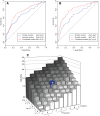Genetic control of the alternative pathway of complement in humans and age-related macular degeneration
- PMID: 19825847
- PMCID: PMC2792151
- DOI: 10.1093/hmg/ddp472
Genetic control of the alternative pathway of complement in humans and age-related macular degeneration
Abstract
Activation of the alternative pathway of complement is implicated in common neurodegenerative diseases including age-related macular degeneration (AMD). We explored the impact of common variation in genes encoding proteins of the alternative pathway on complement activation in human blood and in AMD. Genetic variation across the genes encoding complement factor H (CFH), factor B (CFB) and component 3 (C3) was determined. The influence of common haplotypes defining transcriptional and translational units on complement activation in blood was determined in a quantitative genomic association study. Individual haplotypes in CFH and CFB were associated with distinct and novel effects on plasma levels of precursors, regulators and activation products of the alternative pathway of complement in human blood. Further, genetic variation in CFH thought to influence cell surface regulation of complement did not alter plasma complement levels in human blood. Plasma markers of chronic activation (split-products Ba and C3d) and an activating enzyme (factor D) were elevated in AMD subjects. Most of the elevation in AMD was accounted for by the genetic variation controlling complement activation in human blood. Activation of the alternative pathway of complement in blood is under genetic control and increases with age. The genetic variation associated with increased activation of complement in human blood also increased the risk of AMD. Our data are consistent with a disease model in which genetic variation in the complement system increases the risk of AMD by a combination of systemic complement activation and abnormal regulation of complement activation in local tissues.
Figures

References
-
- Oksjoki R., Kovanen P.T., Mayranpaa M.I., Laine P., Blom A.M., Meri S., Pentikainen M.O. Complement regulation in human atherosclerotic coronary lesions. Immunohistochemical evidence that C4b-binding protein negatively regulates the classical complement pathway, and that C5b-9 is formed via the alternative complement pathway. Atherosclerosis. 2007;192:40–48. - PubMed
-
- Langlois P.F., Gawryl M.S. Detection of the terminal complement complex in patient plasma following acute myocardial infarction. Atherosclerosis. 1988;70:95–105. - PubMed
-
- Gerl V.B., Bohl J., Pitz S., Stoffelns B., Pfeiffer N., Bhakdi S. Extensive deposits of complement C3d and C5b-9 in the choriocapillaris of eyes of patients with diabetic retinopathy. Invest. Ophthalmol. Vis. Sci. 2002;43:1104–1108. - PubMed
-
- Buraczynska M., Ksiazek P., Zukowski P., Benedyk-Lorens E., Orlowska-Kowalik G. Complement factor H gene polymorphism and risk of cardiovascular disease in end-stage renal disease patients. Clin. Immunol. 2009;132:285–290. - PubMed
-
- Brodeur J.P., Ruddy S., Schwartz L.B., Moxley G. Synovial fluid levels of complement SC5b-9 and fragment Bb are elevated in patients with rheumatoid arthritis. Arthritis Rheum. 1991;34:1531–1537. - PubMed
Publication types
MeSH terms
Substances
Grants and funding
LinkOut - more resources
Full Text Sources
Other Literature Sources
Medical
Miscellaneous

